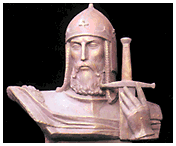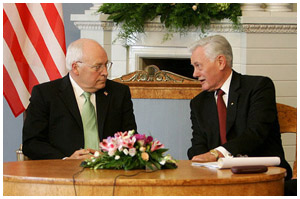LITHUANIAN HISTORY
Lithuania
& Poland Occupation
Occupation Independence
Independence
The Lithuanian language is one of the two surviving members
of the Baltic language group.
Lithuania was first mentioned in a medieval German manuscript,
the Quedlinburg Chronicle, in 1009. The ancestors of the
Lithuanians were Baltic tribes who were united by the Grand
Duke Mindaugas in 1235. Mindaugas 'The Wise' was crowned
in 1253 to become Lithuania's first and only king.

During the regency of Grand Duke Gediminas and his successors
in 1316-1430, Lithuania occupied large territories of present-day
Russia, Belarus, Ukraine, and parts of Poland. By the end
of the 14th century, the Grand Duchy of Lithuania extended
to the Black Sea to form the largest country in Europe.
top
Lithuania and Poland
Lithuania was the last country in Eastern Europe to convert
to Christianity (1387 - 1413) when Poland offered its crown
to Lithuanian Grand Duke Jogaila in 1386. In February, Jogaila
became King of Poland.
Just a few years later, in 1401, the countries' unity broke
up, and Vytautas was appointed Grand Duke of Lithuania.
However, his projected coronation was impeded by a Polish
plot.
In 1569, Poland and Lithuania renewed their state union.
It was only 2 centuries later - in 1795 - that the joint
state was dissolved by the third Partition of the Commonwealth.
It forfeited its territories to Russia (by 90%),
as well as Prussia and Austria (by 10%), under duress.
In 1918 Lithuania briefly achieved independence. King Mindaugas
II then became head of the monarchy until the Lithuanian
parlament opted for a republican form of government. From
the very beginning, its foreign policies were conditioned
by rivalries with Poland and Germany over the territories
of Vilnius and Suvalkai, as well as the so-called 'Memelland'
surrounding Klaipeda.
In the years of 1920 to 1939, Vilnius was annexed by Poland.
During this period, Kaunas became Lithuania's interim capital.
top
Occupation
The Soviets annexed and occupied Lithuania in 1940 in accordance
with the Molotov-Ribbentrop Pact. During the ensuing German
occupation, more than 91% of Lithuania's Jewish
population were killed by the opressor. More than 190,000
people fell victim to the Holocaust.
Shortly after the German retreat in 1944, Lithuania was
again occupied by the Soviets.
During the Soviet dictatorship (1940 to 1954), Lithuania
lost 780,000 of its citizens. The Soviet government killed
or deported to Siberia a number of 120,000 to 300,000 people.
28,000 to 35,000 prisoners were killed, or died of the hardships
in the penal camps or gulags. 21,500 Lithuanians lost their
lives in the fight against Soviet oppression. Another 5,000
civilians were executed. A great number of Lithuanians chose
to go into exile.
Almost half of the buildings in Vilnius were destroyed
during Worl War II. Miraculously, the majority of architectural
benchmarks remained intact except for the Great Synagogue.
Still, there are only few testimonials to the Soviet occupation
who were not destroyed in anger: The sculptures of the Green
Bridge, the red sands on Lukiškiu Platz, and some exhibits
in museums.
Reference and Chronology
After 50 years of Soviet occupation, Lithuania declared
its independency on March 11, 1990. Up until August 31,
1991, the Soviet government tried to forcibly prevent the
secession. 13 Lithuanian civilians died during a Soviet
attack on the Vilnius television tower.
top
Independence
Lithuania joined the United Nations in 1991, and the NATO
in 2004. It was accepted as a member of the European Community
on May 1, 2004.
Since Lithuania declared independence on March 11, 1990,
it has kept strong democratic traditions. The Lithuanian
head of state is the President, elected directly for a five-year
term; he or she may serve a maximum of two consecutive terms.
The President appoints the prime minister and on the latter's
nomination, appoints the rest of the cabinet, as well as
a number of other top civil servants and the judges for
all courts.
Lithuania's parliament is called the 'Seimas'. Its 141
representatives are elected for four-year terms. In order
to be represented in the Seimas, parties need to achieve
at least 5% of votes.

Lithuanian President Valdus
Adamkus and Dick Cheney in the President's Palace, May
2006.
Picture: White House, David Bohrer.
79% of the population are catholics. The roman
catholic church has always played a major part in Lithuanian
society and exerted its influence to fight Soviet oppression.
Nowadays most Lithuanians are bi-lingual. Over 80%
speak Russian fluently. 6.7% of the population are
Poles, 6.3% are Russians.
top


